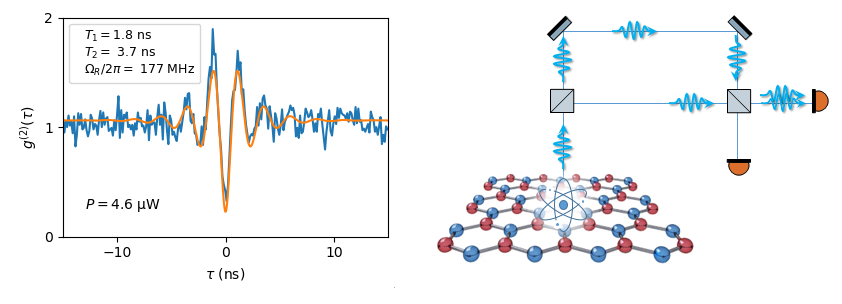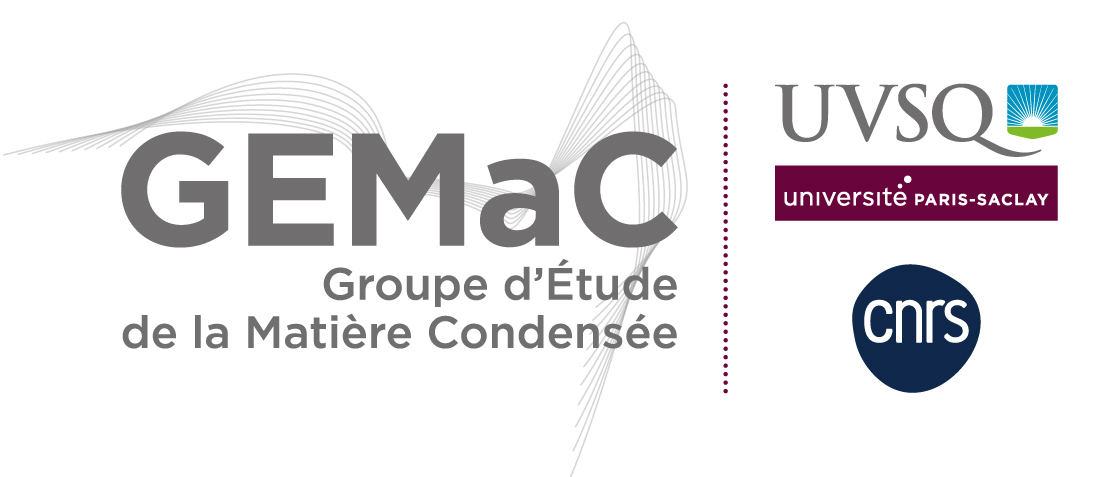You are here : GEMACENHighlights
- Partager cette page :
- PDF version
Coherent photons in two dimensions
Researchers at GEMaC have published two complementary studies demonstrating that single photons emitted by a two-dimensional material are coherent, a property that is essential for applications in quantum computing. This work was the subject of an INP highlight.
Physicists from the Groupe d'étude de la matière condensée (GEMaC, CNRS / UVSQ), in partnership with NIMS (Japan), have studied a particular source of single photons: a 'colour centre' in hexagonal boron nitride. This is a point defect that is created in a controlled manner using a focused electron beam, and which behaves like a single atom trapped in the material. The scientists have published two studies that demonstrate a high level of robustness with regard to decoherence. In the first study, they used a combination of two quantum optics techniques, resonant laser excitation and photon correlations, to study the sources of noise affecting the quantum emitter at low temperature (4 K). Using a model developed specifically for this purpose, they demonstrated that the photons remain coherent, i.e. insensitive to noise, for times corresponding to the emission of a large number of them (around ten thousand).
In their second study, the researchers took advantage of this property to experimentally demonstrate an elementary process that is important for quantum computation: quantum interference between two successive photons. A large number of quantum protocols are based on this phenomenon, known as the "Hong-Ou-Mandel effect", which is only possible if the photons used are indistinguishable from each other, which requires this abovementioned "coherence". Using a dedicated experimental set-up, the scientists demonstrated this quantum interference phenomenon using non-resonant laser excitation of a colour centre - in other words, by generating photons using a pulsed laser with a shorter wavelength. This technique generates a greater loss of coherence than the resonant excitation mentioned above, which limits the amplitude of the interference phenomenon. Nevertheless, there are several ways of optimising the Hong-Ou-Mandel effect so that it can be used for quantum information. One of these avenues, which will be explored in the future, is to integrate the colour centres into optical microcavities, which will enhance the photon emission and reduce the effect of decoherence on this emission.
These two studies are published in Physical Review B and Physical Review Applied respectively.

Figure: On the left, the correlation function of photon emission, showing oscillations that prove the coherence of the emitter. On the right, diagram of the Hong-Ou-Mandel effect: photons are collected and guided so that they can interfere.
References
Two-Photon Interference from a Quantum Emitter in Hexagonal Boron Nitride, Clarisse Fournier, Sébastien Roux, Kenji Watanabe, Takashi Taniguchi, Stéphanie Buil, Julien Barjon, Jean-Pierre Hermier et Aymeric Delteil, Physical Review Applied, paru le 27 avril 2023.
Doi : 10.1103/PhysRevApplied.19.L041003
Open access: arXiv
Investigating the fast spectral diffusion of a quantum emitter in hBN using resonant excitation and photon correlations, Clarisse Fournier, Kenji Watanabe, Takashi Taniguchi, Julien Barjon, Stéphanie Buil, Jean-Pierre Hermier et Aymeric Delteil, Physical Review B, paru le 25 mai 2023.
Doi : 10.1103/PhysRevB.107.195304
Open access: arXiv
Link to INP highlight
Contact: Aymeric Delteil





